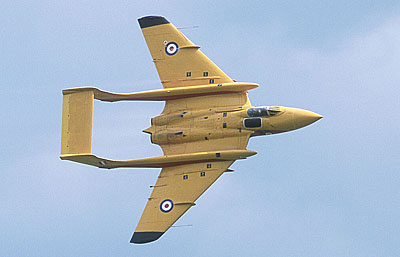 Vixen’s lure Vixen’s lure
Duxford's
May Air Display, 6 May
Gary Parsons reports: Despite the cold wind and overcast conditions, a
bumper crowd was drawn to Duxford for the first airshow of the year (and arguably the new
millennium). Many had come to see the debut of De Havilland Aviation’s Sea Vixen
XP924/G-CVIX, the sixties naval fighter having been a rare sight in the UK skies for many
a year.
 Piloted
by Dan Griffith, he put the supersonic beast through an impressive routine of rolls and
loops, the cloudbase lifting sufficiently for almost a full routine. If there was a
disappointment, it was the fact that the ‘Vixen operated out of nearby Cambridge
Airport for the weekend, denying the Duxford crowd of the opportunity of a landing and
taxi past the crowdline. Some suspected the runway length to be the problem, but it was
due to vital support equipment only being available at Marshall Aerospace. XP924
entered service in 1964 as a FAW2 and saw active service exclusively with 899 Squadron on
HMS Eagle and at Yeovilton. In 1973 she went to Llanbedr to serve as a high-speed radar
target with the Royal Aircraft Establishment and was subsequently converted by Flight
Refuelling to D3 drone status in 1986. The last active Sea Vixen, Piloted
by Dan Griffith, he put the supersonic beast through an impressive routine of rolls and
loops, the cloudbase lifting sufficiently for almost a full routine. If there was a
disappointment, it was the fact that the ‘Vixen operated out of nearby Cambridge
Airport for the weekend, denying the Duxford crowd of the opportunity of a landing and
taxi past the crowdline. Some suspected the runway length to be the problem, but it was
due to vital support equipment only being available at Marshall Aerospace. XP924
entered service in 1964 as a FAW2 and saw active service exclusively with 899 Squadron on
HMS Eagle and at Yeovilton. In 1973 she went to Llanbedr to serve as a high-speed radar
target with the Royal Aircraft Establishment and was subsequently converted by Flight
Refuelling to D3 drone status in 1986. The last active Sea Vixen, 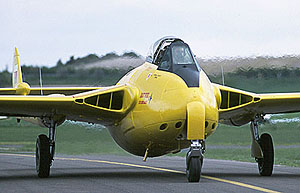 she
was finally retired in 1991. Accompanying the Sea Vixen in a formation flypast was Vampire T11 G-DHAV (in Swiss
Air Force marks) and Meteor NF11 WM167, both from the De
Havilland stable. Dan Griffith later drove from Teversham to fly the Meteor in its solo slot, then promptly went back to the airport
to fly the Vixen home! One hopes he gets overtime! she
was finally retired in 1991. Accompanying the Sea Vixen in a formation flypast was Vampire T11 G-DHAV (in Swiss
Air Force marks) and Meteor NF11 WM167, both from the De
Havilland stable. Dan Griffith later drove from Teversham to fly the Meteor in its solo slot, then promptly went back to the airport
to fly the Vixen home! One hopes he gets overtime!
T-bird rides again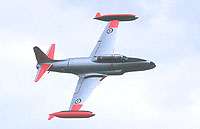 An old airshow stalwart has recently had a facelift, returning to
its original colours in the process. Golden Apple's CT-33A Silver Star Mk 3, serial 21261
(G-TBRD), was one of 656 licence built by Canadair with the more powerful Rolls-Royce Nene
engine, substituting for the American Allison J-33. After fifteen or so years of service
with the Royal Canadian Air Force, '261 was acquired from Canada by the late Ormond
Haydon-Baillie, who went on to display her widely in the UK and Europe during the 1970s as
the 'Black Knight' (then registered G-OAHB and J-JETT). Following time in Switzerland and
on the US register it once more became a regular display star in the 1990s, operated by
the OFMC and flown by Rolf Meum and the late Mark Hanna, sometimes as a duo with Golden
Apple's F-86A Sabre G-SABR.
Silver Star 21261 was inspected for purchase by Golden Apple Operations Ltd. in late
1990, but not until 1996 was a deal agreed with the OFMC. A lengthy restoration project
under Chief Engineer Roger Shepherd and the late John Chillingworth commenced, culminating
in the granting of its Permit to Fly by the CAA in October 2000, at which point
engineering responsibility was transferred to The Aircraft Restoration Company. Since
then, ARC, under John Romain and Nev Gardner, have continued with the final stages,
including putting '261 back in its original markings when in service with the RCAF, for
which the Canadian Government has kindly given its permission. The detailing of the
markings is accurately based on original drawings and specs from Canada.

Back in the late forties, Lockheed took the view that the new jet age
demanded a new approach to pilot training and as an entirely private venture built the two
seat T-33, or TP-80C as it was first designated. As Kelly Johnson put it, "The
Government needs a jet trainer. Right now they don't want it, but they're going to get it,
and I think they will like it". For an investment of a million dollars, Lockheed went
on to build close to 6,000 T-Birds, Canadair 656 and Kawasaki 200. Over fifty years later
some of them are still in service. The Lockheed trainer was basically a P-80 with a
fuselage plug ahead of the wing and a second plug aft to create a generous tandem
dual-control cockpit. The improved fineness ratio of the longer fuselage resulted in even
better performance for the trainer than the fighter, as has often been the case with the
American tandem seat trainers. As test pilot Tony LeVier said of the prototype he first
flew on 22nd March 1948, "It flies like a P-80, only faster!"
The T-33 will be flown during the airshow season by Air Marshal Cliff Spink, ex-Fighter
pilot who led Tornado Fighters in Desert Storm, and Rolf Meum, ex-Royal Norwegian Air
Force, who was once the youngest fast jet pilot in NATO and is now a captain with SAS.
Rolf carried out the first flight on G-TBRD following its restoration and also flies
Golden Apple's Sabre. By coincidence his father was a T-33 instructor with the Royal
Norwegian Air Force and one of his present day SAS colleagues enjoyed his first T-Bird
solo with the CAF on 21261, now G-TBRD. |
Completing the vintage jet quota alongside McCarthy Aviation's Strikemaster
was Vampire G-GONE. An ex-Swiss example (J-1542), it is also owned by De Havilland
Aviation and sparkled in a coat of bright yellow. Much discussion ensued on what
country’s markings the fin flash represented - it wasn’t some obscure South
American tinpot dictatorship, but Wales! It’s not the formation of an independent
Welsh Air Force, just that the aeroplane's owner, Gwyn Jones, is Welsh (rather
unsurprisingly with a name like that!).
Hello Blackbird
The Sea Vixen may have been star of the flying, but just as much interest was shown in
the museum’s latest acquisition, the SR-71 Blackbird. Fresh
from its journey across the Atlantic, the Blackbird is the only one in captivity outside
the USA and set to be the centrepiece of the American Air Forces museum. For now it sits
in the Superhangar, awaiting some attention as she has seen better days and suffered some
minor damage from the long journey. Once the IWM’s staff have worked their
restoration magic, it will, no doubt, look better than new. Entry to the airshow also
includes full access to all the museum exhibits, making a very full day if you
haven’t been before.
Sometimes smoking
is good for you...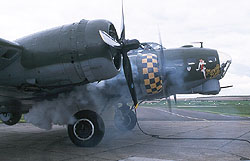 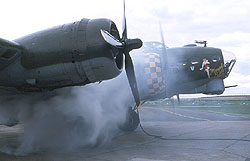 ...as it
means the engines have fired, and life breathes through an old war-horse again. B17G
‘Sally B’ is celebrating another year on the airshow circuit, but times are
still hard for Elly Sallingboe and the crew. Fortunes have turned around since that
disastrous winter in Jersey that consumed engines as if they were going out of fashion; a
particularly smoky start at Duxford signalled all four engines were in the best of health
as the oil was burnt from the inverted cylinders on the Wright Cyclones. Airshow
appearances will still be rare this year, but she should be commemorating her fallen
colleagues at Mildenhall’s Air Fete at the end of the month. Next year will be the
sixtieth anniversary of the arrival of the USAAF in the UK, so her services will be in big
demand. Maybe it’s time for the US Military to step in with some financial
assistance? Long may she spread her wings over Eastern England. |
Goodbye Hurricane?
 Alongside TFC's Z7381, Hawker Restorations’ Hurricane AE977 was in attendance, but this may have been one of the last
chances to see this particular bird as it is rumoured that it
has very recently been sold to a buyer from America. If so, it will be sad to see it go,
but every cloud has a silver lining as it should provide another restoration project with
the funds to commence. Many are on the go at present, both at Duxford and nearby Audley
End, so the future of warbird restoration in the UK seems healthy. As an example, TFC plan
to have a Beaufighter flying in a couple of years, something not seen in the British skies
for many decades. Parked alongside HAC's Spitfire BM597, it made
for some very atmospheric photography. Alongside TFC's Z7381, Hawker Restorations’ Hurricane AE977 was in attendance, but this may have been one of the last
chances to see this particular bird as it is rumoured that it
has very recently been sold to a buyer from America. If so, it will be sad to see it go,
but every cloud has a silver lining as it should provide another restoration project with
the funds to commence. Many are on the go at present, both at Duxford and nearby Audley
End, so the future of warbird restoration in the UK seems healthy. As an example, TFC plan
to have a Beaufighter flying in a couple of years, something not seen in the British skies
for many decades. Parked alongside HAC's Spitfire BM597, it made
for some very atmospheric photography.
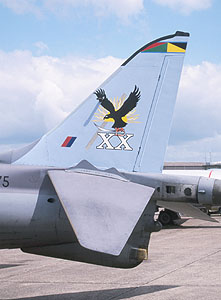
RAF colour! RAF support for
this first event of the year was good, with a welcome return for the solo Hawk, plus regular Harrier GR7 and Tucano displays. Both the Hawk and Harrier sported special paint
schemes, the former celebrating the 60th anniversary of RAF Valley. The Harrier had 20(R)
Squadron’s eagle and sword emblazoned against a light blue background, providing some
welcome colour to the normal drab grey.
Commemorating a hero
Completing the RAF’s involvement, excepting the
parachute display team Falcons, no less than three Pumas from 33
Squadron were in attendance, helping with the Crete anniversary set-piece. Maybe something
of an odd theme, it is sixty years since the Battle of Crete in which 33 played a major
role - one of the war's aces, Sqn Ldr 'Pat' Pattle, a South African by birth, took  command of 33 Squadron at the beginning of 1941. By 20th April his score
had reached at least 50, making him the RAF's top-scoring pilot of the war. On that day,
he had a high temperature and was very sick, suffering from influenza and fatigue, but
despite this insisted on taking off to follow the remnants of Nos 80 and 33 Squadrons to
meet more than 100 enemy aircraft. With fifteen other Hurricanes, which were the only
fighters left in Greece, he was command of 33 Squadron at the beginning of 1941. By 20th April his score
had reached at least 50, making him the RAF's top-scoring pilot of the war. On that day,
he had a high temperature and was very sick, suffering from influenza and fatigue, but
despite this insisted on taking off to follow the remnants of Nos 80 and 33 Squadrons to
meet more than 100 enemy aircraft. With fifteen other Hurricanes, which were the only
fighters left in Greece, he was  1,000 feet
above a defensive circle of Bf110s when he saw a single Hurricane climbing towards them -
a single Bf110 peeled off from the circle to dive at it. Pattle cut through the Bf110s to
protect the lone Hurricane's tail, pulled up under the 110 which was firing into the
Hurricane and shot it down, thereby saving the life of Timber Woods (who after shooting
down two 110s was himself shot down and killed later in the day). Pattle pulled his
Hurricane round and dived into a space between the 110s, shooting down another as he did
so. He was last seen diving in flames, slumped forward across his instrument panel, his
aircraft falling into Eleusis bay. 1,000 feet
above a defensive circle of Bf110s when he saw a single Hurricane climbing towards them -
a single Bf110 peeled off from the circle to dive at it. Pattle cut through the Bf110s to
protect the lone Hurricane's tail, pulled up under the 110 which was firing into the
Hurricane and shot it down, thereby saving the life of Timber Woods (who after shooting
down two 110s was himself shot down and killed later in the day). Pattle pulled his
Hurricane round and dived into a space between the 110s, shooting down another as he did
so. He was last seen diving in flames, slumped forward across his instrument panel, his
aircraft falling into Eleusis bay.
 Joining the Pumas in the set-piece display was CH53G 85+09 from the German Army, although not officially as the
‘baddies’. More used to American MH53s at Duxford, the ’53 was the only
international participant, the Americans conspicuous by their absence. The stars &
stripes were left to B17 ‘Sally B’ and the P51s and P40s
of the OFMC and TFC, usual faces but very welcome, nonetheless. Joining the Pumas in the set-piece display was CH53G 85+09 from the German Army, although not officially as the
‘baddies’. More used to American MH53s at Duxford, the ’53 was the only
international participant, the Americans conspicuous by their absence. The stars &
stripes were left to B17 ‘Sally B’ and the P51s and P40s
of the OFMC and TFC, usual faces but very welcome, nonetheless.
De Havilland tribute
Much of the early part of the flying display was
dominated by both De Havilland and de Havilland aircraft; two different entities, the
former now operate the classic jets of the fifties and sixties while the latter is a
long-gone aircraft builder, famous for the Tiger Moth, Mosquito et al. In a
between-the-wars scenario, Shuttleworth Collection biplanes
followed a collection of de Havilland Moths of all types, taxing
the abilities of the most hardened aircraft recognition champion with the subtle
differences between the types.
Statically charged
Together with the classic jets, the RAF contingent made
for a very nice line-up on the flightline, and the opportunity to walk amongst them for a
couple of hours plus get closer to the warbirds is  always appreciated at Duxford. The mile-long
crowdline always offers an excellent chance to get up close to the taxiing aircraft, none
more so than ‘Sally B’ who wove her way down the taxiway, starboard wing almost
within fingertip reach. always appreciated at Duxford. The mile-long
crowdline always offers an excellent chance to get up close to the taxiing aircraft, none
more so than ‘Sally B’ who wove her way down the taxiway, starboard wing almost
within fingertip reach.
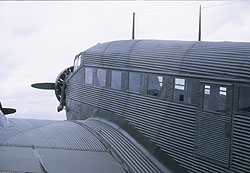 Back on the scene after a
few years absence were T33 G-TBRD (see column) and Fiat G46 G-BBII of Personal Plane Services, both having had extensive
rebuilds and wearing new paint schemes. As a finale, OFMC's Breitling Fighters quartet of Corsair, P40,
P51 and Spitfire beat up the airfield in their usual style. Back on the scene after a
few years absence were T33 G-TBRD (see column) and Fiat G46 G-BBII of Personal Plane Services, both having had extensive
rebuilds and wearing new paint schemes. As a finale, OFMC's Breitling Fighters quartet of Corsair, P40,
P51 and Spitfire beat up the airfield in their usual style.
 They think it's all over... They think it's all over...
By the end of the afternoon, the clouds had parted and
the sun brought some welcome warmth to the day. As the airshow has normally been held on
the Bank Holiday Monday, a change to the Sunday this year meant Monday was, of course,
gloriously warm and sunny. It’s good to know that the airshow season has started, and
is running true to form!

|
 Vixen’s lure
Vixen’s lure

 she
was finally retired in 1991. Accompanying the Sea Vixen in a formation
she
was finally retired in 1991. Accompanying the Sea Vixen in a formation 



 Alongside TFC's Z7381, Hawker Restorations’ Hurricane
Alongside TFC's Z7381, Hawker Restorations’ Hurricane 


 Joining the Pumas in the set-piece display was CH53G
Joining the Pumas in the set-piece display was CH53G 
 Back on the scene after a
few years absence were
Back on the scene after a
few years absence were  They think it's all over...
They think it's all over...